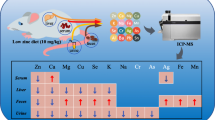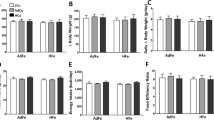Abstract
To examine whether zinc deficiency would increase the toxicity of dietary aluminum, weanling, male Sprague-Dawley rats were fed purified diets containing either 2 or 30 mg Zn/kg diet, with or without 500 mg Al/kg diet for 28 d. Individually pair-fed rats were fed the 30 mg Zn/kg diet with or without added aluminum to control for inanition secondary to zinc deficiency. Rats fed the 2 μg Zn/kg diet showed evidence of zinc deficiency, including anorexia, growth retardation, and depressed concentrations of zinc in tibias and livers. Zinc deficiency did not significantly increase the concentrations of aluminum in the tibias, livers, kidneys, or regions of the brain examined (cerebrum, cerebellum, midbrain, and hippocampus). Inclusion of aluminum in the diet did not alter aluminum concentrations in the various tissues. Under the conditions of this study, zinc deficiency did not result in greater sensitivity to dietary aluminum exposure.
Similar content being viewed by others
References
A. C. Alfrey, Aluminum metabolism in uremia,Neurotoxicology 1, 43–54 (1980).
M. K. Ward, T. G. Feest, H. A. Ellis, I. S. Parkinson, D. N. S. Kerr, J. Herrington and G. L. Goode, Osteomalacic dialysis osteodystrohpy, evidence for a water-borne aetological agent, probably aluminum. The Lancet April 22, 841–845 (1978).
D. C. Gajdusek and A. M. Salazar, Amyotrophic lateral sclerosis and parkinsonian syndromes in high incidence amount the Auyu and Jakia people of West New Guinea.Neurology 32, 107–126 (1982).
P. O. Ganrot, Metabolism and possible health effects of aluminum.Environ. Health Perspect. 65, 363–441 (1986).
R. Ondreika, E. Ginter and J. Kortus, Chronic toxicity of aluminum in rats and mice and its effects on phosphorus metabolism,Brit. J. Indust. Med. 23, 305–312 (1966).
R. Ondreika, J. Kortus, and E. Ginter, Absorption, distribution and effects on phosporus metabolism, inIntestinal Absorption of Metal Ions Trace Elements and Radionuclides, S. C. Skoryna and D. Waldron-Edward, eds., Pergamon P, New York, pp. 293–305 (1980).
J. L. Greger, E. N. Bula, and E. T. Gum, Mineral metabolism of rats fed moderate levels of various aluminum compounds for short periods of time.J. Nutr. 115, 1708–1716 (1985).
J. L. Greger, E. T. Gum and E. N. Bula, Mineral metabolism of rats fed various levels of aluminum hydroxide.Biol. Trace Element Res. 9, 67–77 (1985).
G. L. Wenk and K. L. Stemmer, Suboptimal dietary zinc intake increases aluminum accumulation into the rat brain,Brain Res. 288, 393–395 (1983).
C. A. Ecelbarger and J. L. Greger, Dietary citrate and kidney function affect aluminum, zinc and iron utilization in rats.J. Nutr. 121, 1755–1762 (1991).
J. M. Donald, M. S. Golub, M. E. Gershwin and C. L. Keen, Neurobehavioral effects in offspring of mice given excess aluminum in diet during gestation and lactation.Neurotoxicology Teratogenesis 11, 345–351 (1989).
G. B. Van der Voet, Intestinal absorption of aluminum: Relation to Neurotoxicity, inThe Vulnerable Brain and Environmental Risks, vol. 2:Toxins in Food, R. L. Isaacson and K. F. Jensen, eds., Plenum, New York, p. 35 (1992).
G. L. Wenk and K. L. Stemmer, Activity of the enzymes dopamine-beta-hydroxylase and phenylethanolamine-N-methyltransferase in discrete brain regions of the copperzinc deficient rat following aluminum ingestion.Neurotoxicology 3, 93–99 (1982).
American Institute of Nutrition, Report of the AIN Ad Hoc Committee on standards for nutritional studies.J. Nutr. 107, 1340–1348 (1977).
M. S. Clegg, C. L. Keen, B. Lonnerdahl and L. Hurley, Influence of ashing techniques on the analysis of trace elements in animal tissues. I. wet ashing.Biol. Trace Element Res. 3: 107–115.
J. Neten, W. Wasserman, and M. H. Kutner,Applied Linear Statistical Models. 3rd ed. Irwin, Boston, p. 225 (1991).
D. K. Abu-Hamdan, S. K. Mahajan, S. D. Migdal, A. S. Prasad, and F. D. McDonald, Zinc tolerance in uremia, effect of ferrous sulfate and aluminum hydroxide.Ann. Int. Med. 104, 50–52 (1986).
D. Gawlik, P. Bratter, P. Gardiner and W. Gatschke, Aluminum in the maintenance diet of rats.Trace Element Anal. Chem. Med. Biol. 4, 431–442 (1987).
R. B. Williams and C. F. Mills, The experimental production of zinc deficiency in the rat,Br. J. Nutr. 24, 989–1003 (1970).
M. K. Hambidge, M. E. Casey, and N. F. Krebs, Zinc, inTrace Elements in Human and Animal Nutrition, 5th ed. Academic, New York, pp. 1–137 (1986).
M. J. Jackson, D. A. Jones, and R. H. T. Edwards, Tissue zinc levels as an index of body zinc status.Clin. Phys. 2, 333–343 (1982).
R. Giugliano and D. J. Millward, Growth and zinc homeostasis in the severely Zn-deficient rat. Br. J. Nutr.5, 545–560 (1984).
J. H. Park, C. J. Grandjean, D. L. Antonson, and J. A. Vanderhoof, Effects of isolated zinc deficiency on the composition of skeletal muscle, liver and bone during growth in rats,J. Nutr. 116, 610–617 (1986).
N. C. Bowdler, Beasley, E. C. Fritz, A. M. Goulette, J. D. Hatton, J. Hession, D. L. Ostman, D. J. Rugg, and C. J. Schmittdiel, Behavioral effects of aluminum ingestion on animal and human subjects.Pharm. Biochem. and Behav. 10, 505–512 (1979).
R. D. Martin, Chemistry of aluminum as related to biology and medicine.Clin. Chem. 32: 1797–1806 (1986).
N. A. Partridge, F. E. Regnier, W. M. Reed, J. L. White and S. L. Hem. Contribution of soluble aluninum species to absorption of aluminum from rat gut in Situ.Clin. Sci. 83: 425–430 (1992).
J. L. Greger and S. E. Donnaubauer, Retention of aluminum in the tissues of rats after the discontinuation of oral exposure to aluminum.Food. Chem. Toxic 24, 1331–1334 (1986).
P. Slanina, Y. Falkeborn, W. Frech and A. Cedergren, Aluminum concentrations in the brainand bone of rats fed citric acid, aluminum citrate or aluminum hydroxide.Food Chem. Toxic. 22, 391–397 (1984).
G. J. Fosmire, S. Focht, and J. McLearn, Genetic influence on tissue deposition of aluminum in mice.Biol. Trace Element Res. 37, 115–121 (1993).
J. Wensink, C. H. Paays and C. Van der Hamer, Uptake and turnover of65Zn in subcellular fractions of brain in the rat under normal and zinc deficient conditions,Biol. Trace Element Res. 14, 127–140 (1987).
E. J. Kasarskis, Regulation of zinc homeostasis in the rat brain, inThe Neurobiology of Zinc, part A, C. J. Frederickson, G. A. Howell, and E. J. Kasarskis, eds. Alan R. Liss, New York, pp. 27–37 (1984).
Author information
Authors and Affiliations
Rights and permissions
About this article
Cite this article
McNall, A.D., Fosmire, G.J. Zinc status does not affect aluminum deposition in tissues of rats. Biol Trace Elem Res 53, 7–18 (1996). https://doi.org/10.1007/BF02784540
Received:
Accepted:
Issue Date:
DOI: https://doi.org/10.1007/BF02784540




